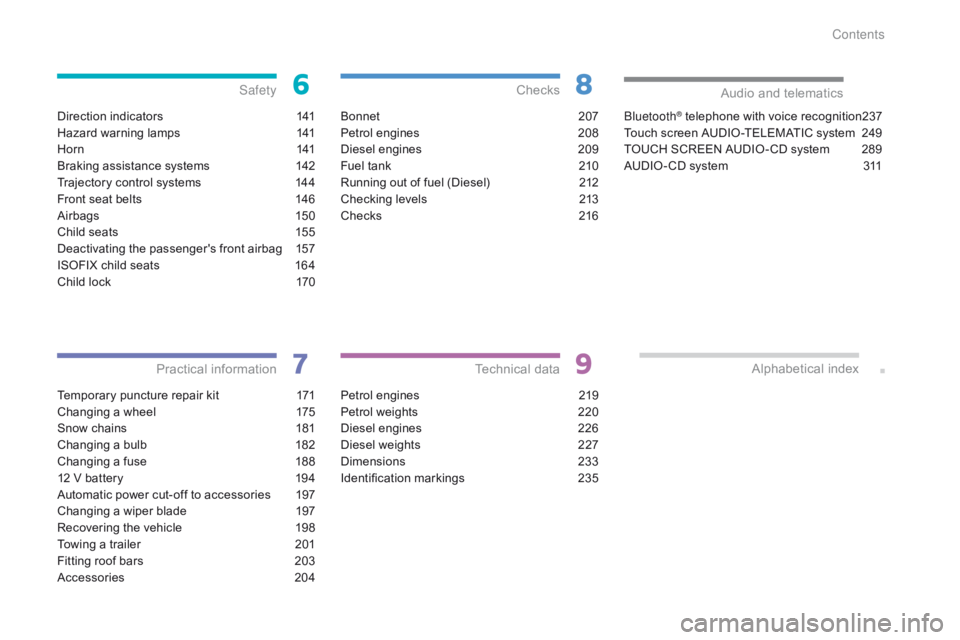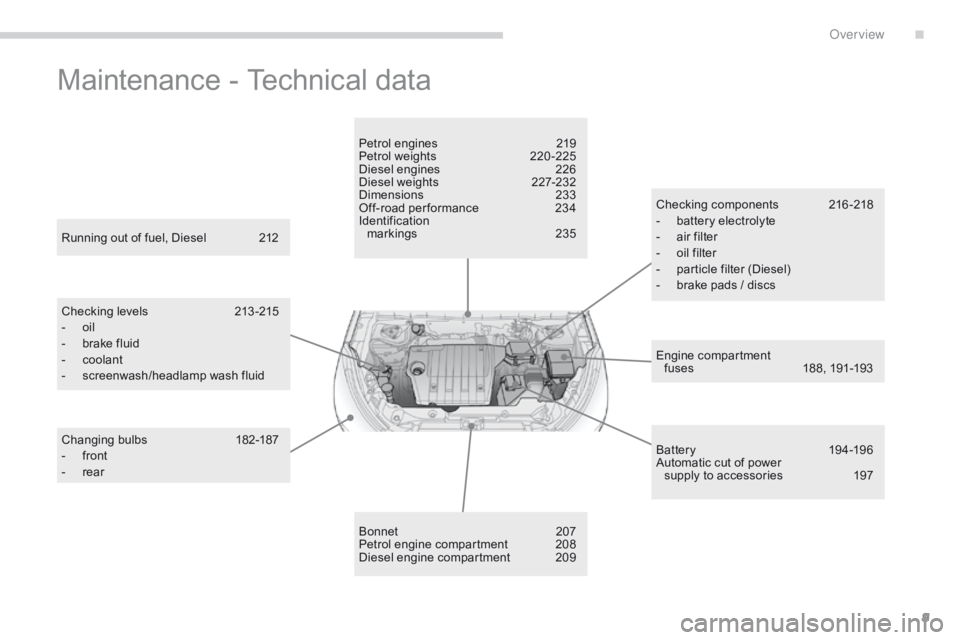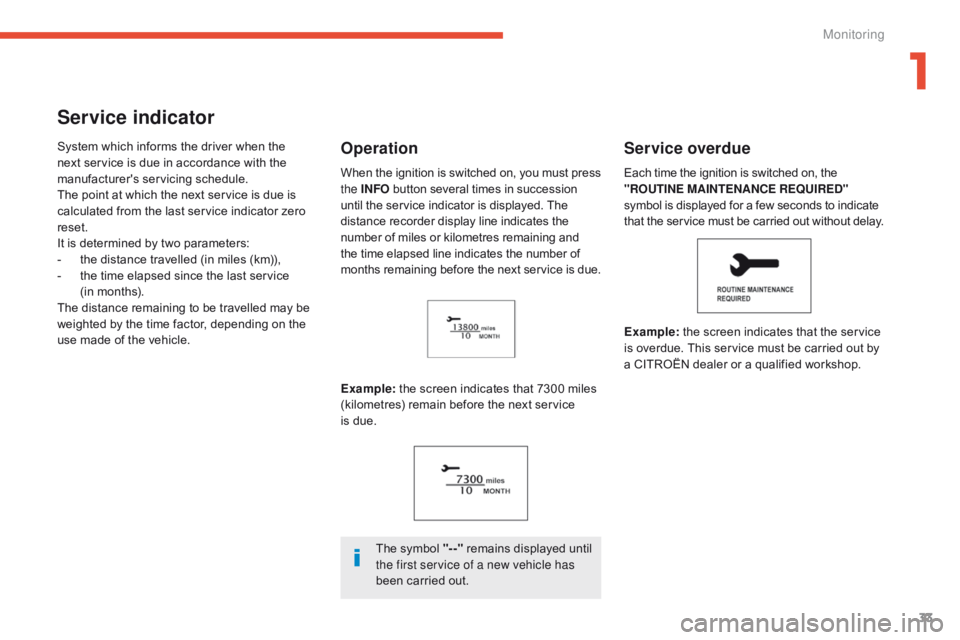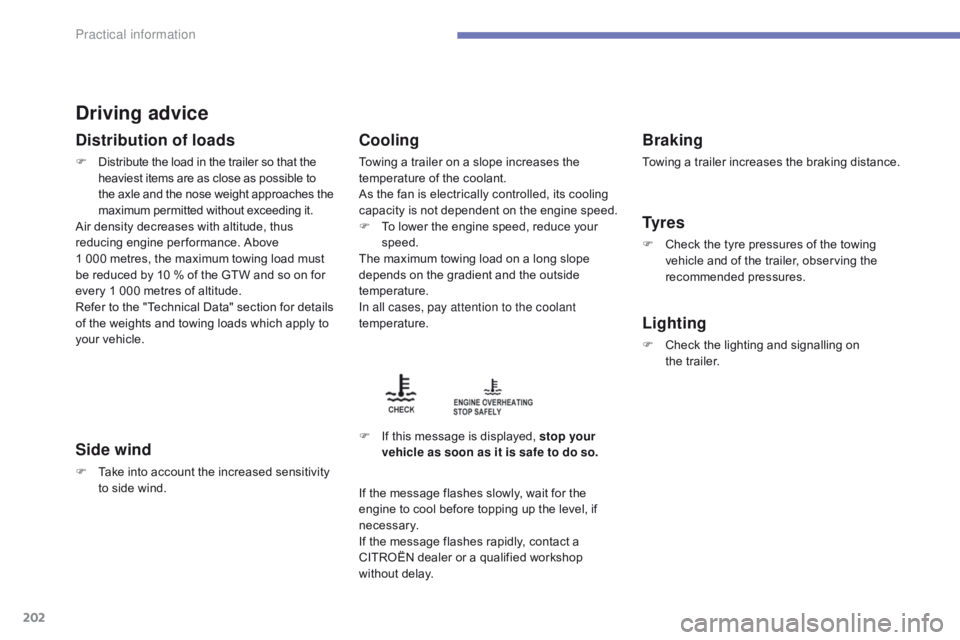weight CITROEN C4 AIRCROSS 2021 Handbook (in English)
[x] Cancel search | Manufacturer: CITROEN, Model Year: 2021, Model line: C4 AIRCROSS, Model: CITROEN C4 AIRCROSS 2021Pages: 414, PDF Size: 20.29 MB
Page 5 of 414

Direction indicators 141
Hazard warning lamps
1
41
H o r n
1
41
Braking assistance systems
1
42
Trajectory control systems
1
44
Front seat belts
1
46
Airbags
1
50
Child seats
1
55
Deactivating the passenger's front airbag
1
57
ISOFIX child seats
1
64
Child lock
1
70
Safety
Temporary puncture repair kit 1 71
Changing a wheel
1
75
Snow chains
1
81
Changing a bulb
1
82
Changing a fuse
1
88
12 V battery
1
94
Automatic power cut-off to accessories
1
97
Changing a wiper blade
1
97
Recovering the vehicle
1
98
Towing a trailer
2
01
Fitting roof bars
2
03
Accessories
2
04
Practical information
Bonnet 20 7
Petrol engines
2
08
Diesel engines
2
09
Fuel tank
2
10
Running out of fuel (Diesel)
2
12
Checking levels
2
13
Checks
2
16
Checks
Petrol engines 2 19
Petrol weights
2
20
Diesel engines
2
26
Diesel weights
2
27
Dimensions
2
33
Identification markings
2
35
Technical data
bluetooth® telephone with voice recognition 237
Touch screen AUDIO -TELEMATIC system
2
49
TOUCH SCREEN AUDIO - CD system
2
89
AUDIO - CD system
3
11
Audio and telematics
Alphabetical index
Contents
Page 11 of 414

9
Maintenance - Technical data
Engine compartment
fuses 1 88, 191-193
Running out of fuel, Diesel
2
12
Checking levels
2
13 -215
-
o
il
-
b
rake fluid
- c
oolant
-
s
creenwash/headlamp wash fluid
Changing bulbs
1
82-187
-
f
ront
-
r
ear Petrol engines
2
19
Petrol weights
2
20 -225
Diesel engines
2
26
Diesel weights
2
27-232
Dimensions
2
33
Off-road performance
2
34
Identification
markings
2
35
Bonnet
20
7
Petrol engine compartment
2
08
Diesel engine compartment
2
09 Bat ter y
19
4 -19 6
Automatic cut of power supply to accessories
1
97
Checking components
2
16 -218
-
b
attery electrolyte
-
a
ir filter
-
o
il filter
-
p
article filter (Diesel)
-
b
rake pads / discs
.
over view
Page 35 of 414

33
Service indicator
System which informs the driver when the
next service is due in accordance with the
manufacturer's servicing schedule.
The point at which the next service is due is
calculated from the last service indicator zero
reset.
It is determined by two parameters:
-
t
he distance travelled (in miles (km)),
-
t
he time elapsed since the last service
(in months).
The distance remaining to be travelled may be
weighted by the time factor, depending on the
use made of the vehicle.
Example: the screen indicates that 7300 miles
(kilometres) remain before the next service
is due.Service overdue
Example: the screen indicates that the service
is overdue. This service must be carried out by
a CITROËN dealer or a qualified workshop.
Operation
The symbol "-- " remains displayed until
the first service of a new vehicle has
been carried out. Each time the ignition is switched on, the
"ROUTINE MAINTENANCE REQUIRED"
symbol is displayed for a few seconds to indicate
that the service must be carried out without delay.
When the ignition is switched on, you must press
the
INFO button several times in succession
until the service indicator is displayed. The
distance recorder display line indicates the
number of miles or kilometres remaining and
the time elapsed line indicates the number of
months remaining before the next ser vice is due.
1
Monitoring
Page 157 of 414

155
General points relating to child seats
For maximum safety, please observe the
following recommendations:
-
i
n accordance with European regulations,
all children under the age of 12 or less
than one and a half metres tall must
travel in approved child seats suited to
their weight , on seats fitted with a seat
belt or ISOFIX mountings*,
-
s
tatistically, the safest seats in your
vehicle for carr ying children are the
rear seats,
-
a c
hild weighing less than 9 kg must
travel in the rearward facing position
both in the front and in the rear. CITROËN recommends
that children
should travel on the rear seats of your
vehicle:
-
r
earward facing up to the age of 3,
-
fo
rward facing over the age of 3.
Although one of CITROËN main criteria when designing your vehicle, the safety of your children
also depends on you.
*
T
he regulations on carrying children are
specific to each country. Refer to the
legislation in force in your country.
6
Safety
Page 164 of 414

162
Locations for child seats secured using the seat beltIn accordance with European regulations, this table indicates the options for installing child seats secured using a seat belt and universally approved (a)
in relation to the weight of the child and the seat in the vehicle.Seat Weight of the child and indicative age
Less than 13 kg
(groups 0 (b) and 0+) Up to ≈ 1 year From 9 to 18 kg
(group 1)
From 1 to ≈ 3 years From 15 to 25 kg
(group 2)
From 3 to ≈ 6 years From
22 to 36 kg
(group 3)
From 6 to ≈ 10 years
Front passenger seat (c) with
passenger airbag activated X
XXX
Front passenger seat (c) with
passenger airbag deactivated L1
L2, L3 XX
ou
ter rear seats
(row 2) (d) U
UUU
Centre rear seat
(row 2) (d) L1
L2, L3 XX
Safety
Page 165 of 414

163
(a) Universal child seat: child seat which can be installed in all vehicles using the seat belt.
(b)
G
roup 0: from birth to 10 kg. Infant car seats
and "car cots" cannot be installed on the
front passenger seat.
(c)
C
onsult the legislation in force in your
country before installing your child on this
seat.
(d)
T
o install a child seat on a rear seat,
rear ward or for ward facing, move the front
seat for ward, then straighten the backrest,
so as to leave sufficient space for the child
seat and the child's legs. Remove and stow the head restraint
before installing a child seat with a
backrest on a passenger seat. Refit the
head restraint once the child seat has
been removed.
U:
s eat suitable for the installation of a child
seat secured using the seat belt and
universally approved, "rear ward facing" and/
or "for ward facing".
X:
s
eat not suitable for the installation of a child
seat of the weight group indicated.
L-:
o
nly the child seats indicated can be
installed on the seat concerned (according
to country).
6
Safety
Page 170 of 414

168
Locations for ISOFIX child seats
In accordance with European Regulations, this table indicates the options for installing ISOFIX child seats on seats in the vehicle fitted with ISOFIX
mountings.
In the case of universal and semi-universal ISOFIX child seats, the ISOFIX size category, determined by a letter between A and G, is indicated on the
child seat next to the ISOFIX logo.
Weight of the child / indicative age
Less than 10 kg (group 0)
Up to approx. 6
monthsLess than 10 kg
(group 0)
Less than 13 kg
(group 0+)
Up to approx. 1 year From 9 to 18 kg (group 1)
From approx. 1 to 3 years
Type of ISOFIX child seat infant car seat "rearward facing"
"rearward facing""forward facing"
ISOFIX size categor y F G C D E C D A B B1
Universal and semi-universal ISOFIX child
seats which can be installed on the outer
rear seat s X
XI L1IL2 X IUF
I UF:
s
eat suitable for the installation of an I sofix Universal seat, " For ward facing" secured using the
"Top Tether" upper strap.
IL-:
o
nly the child seats indicated can be installed using the ISOFIX mountings.
For advice on securing of the "Top Tether" upper strap, refer to the "ISOFIX mountings" section.
X: seat not suitable for the installation of an ISOFIX seat of the size category indicated. Remove and stow the head restraint
before installing a child seat with a
backrest on a passenger seat. Refit the
head restraint once the child seat has
been removed.
Safety
Page 200 of 414

198
Recovering the vehicle
Recovery of your vehicle
2 wheel drive (2WD) versions: towing
with the wheels on the ground
F Put the gear lever into neutral (position N
for the CVT gearbox).
F
U
nlock the steering by by turning the
ignition switch to the " ON" position (or
to " ON " mode for vehicle fitted with the
"Keyless Entry and Starting" system).
F
R
elease the parking brake.
F
S
witch on the hazard warning lamps on
both vehicles.
F
M
ove off gently and travel slowly for a short
distance only.
General recommendations
Observe the legislation in force in your
c o unt r y.
Ensure that the weight of the towing
vehicle is higher than that of the towed
vehicle.
The driver must remain at the wheel of
the towed vehicle and must have a valid
driving licence.
When towing a vehicle with all four
wheels on the ground, always use an
approved towing bar; rope and straps
are prohibited.
When towing a vehicle with the engine
off, there is no longer any power
assistance for braking or steering.
In the following cases, you must always
call on a professional recovery service:
-
v
ehicle broken down on a motor way
or fast road,
-
4 w
heel drive vehicle,
-
w
hen it is not possible to put the
gearbox into neutral, unlock the
steering, or release the parking
brake,
-
t
owing with only two wheels on the
ground,
-
w
here there is no approved towing
bar available... Towing with the wheels on the ground
is only possible on 2 wheel drive (2WD)
versions.
F
F
it the towing bar to the towing eye on the
chassis, located under the front bumper.
Practical information
Page 204 of 414

202
Driving advice
Distribution of loads
F Distribute the load in the trailer so that the heaviest items are as close as possible to
the axle and the nose weight approaches the
maximum permitted without exceeding it.
Air density decreases with altitude, thus
reducing engine per formance. Above
1
000 metres, the maximum towing load must
be reduced by 10
% of the GTW and so on for
every 1
000 metres of altitude.
Refer to the "Technical Data" section for details
of the weights and towing loads which apply to
your vehicle.
Side wind
F Take into account the increased sensitivity to side wind.
Cooling
Towing a trailer on a slope increases the
temperature of the coolant.
As the fan is electrically controlled, its cooling
capacity is not dependent on the engine speed.
F
T
o lower the engine speed, reduce your
speed.
The maximum towing load on a long slope
depends on the gradient and the outside
temperature.
In all cases, pay attention to the coolant
temperature.
F
I
f this message is displayed, stop your
vehicle as soon as it is safe to do so.
Braking
Towing a trailer increases the braking distance.
Ty r e s
F Check the tyre pressures of the towing vehicle and of the trailer, observing the
recommended pressures.
Lighting
F Check the lighting and signalling on the trailer.
If the message flashes slowly, wait for the
engine to cool before topping up the level, if
necessary.
If the message flashes rapidly, contact a
CITROËN dealer or a qualified workshop
without delay.
Practical information
Page 205 of 414

203
Fitting roof bars
The transverse roof bars are fitted to the longitudinal bars at the 8 fixing points masked by covers.
Using a small screwdriver, remove the 8 covers on the inner faces of the longitudinal bars.
The transverse bars are fitted directly to the roof of the vehicle, at the 4 anchorage points masked
by covers.
Slide the covers towards the front of the vehicle to remove them.
Retain the protective covers.
After removing the roof bars, the protective covers should be refitted:
F
i
nsert the fixing tongues into the apertures then slide the covers towards the rear of the vehicle. The body sill finishers should not be
used as a step when fitting roof bars.Use accessories recommended by
CITROËN and follow the accessory
manufacturer's fitting instructions.
Maximum authorised weight on the roof
bars, for a loading height not exceeding
40
cm (except bicycle carriers): 80 kg.
If the height exceeds 40 cm, adapt the
speed of the vehicle to the condition of
the road, to avoid damaging the roof
bars and the fixings on the roof.
Please refer to national legislation to
comply with the regulations regarding
the transportation of objects which are
longer than the vehicle.
For reasons of safety and to avoid damaging the roof, it is essential to use transverse bars that are
approved for your vehicle.
Vehicles fitted with longitudinal bars
Vehicles not fitted with longitudinal bars
7
Practical information